GOMA. A place where people come together
In 2001, then Architectus Design Directors Kerry Clare, Lindsay Clare and James Jones won an Architect Selection Competition to design the new Gallery of Modern Art (GOMA) in Brisbane. Construction began in 2002 and was completed in 2006, coinciding with the launch of the ‘The 5th Asia Pacific Triennial of Contemporary Art’.
GOMA quickly became a darling of the people, a much-discussed landmark, and a cultural hub for Brisbane and Queensland. The building, defined by a dual black box/white box arrangement, is perhaps most memorable to visitors for its lightfilled, lucid spaces. But this clarity and apparent ease underlies a complex and technically advanced system of flexible spaces that can adapt and re-form for the most varied needs of contemporary art.
In 2007, Architectus was awarded both the National and State (Queensland) RAIA Awards for Public Architecture, and in 2010 the Clares both received the prestigious RAIA Gold Medal. Here, Lindsay and Kerry reflect on the early days of design and how they now respond to GOMA.

GOMA construction Photograph by Peter Liddy Camera scan of black and white medium format negative / View full image
TEN YEARS ON, WHAT DO YOU SEE AND HOW DO YOU FEEL WHEN YOU VISIT GOMA?
Kerry Clare | We have always really enjoyed going there because [GOMA] was built as a framework for art, so every time we visit, it has a new interior. It’s just delightful to see how many different interpretations there are, and how artists and curators respond to it.
Lindsay Clare | The enjoyment we get out of it is in the fact that so many people, young and old, and from different walks of life, just seem to be enjoying it. That’s the best result an architect can have with any building — that it’s useful and much-loved. And the building still has unexplored potential, which we are currently discussing.
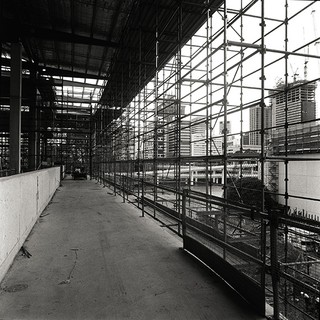
GOMA construction Photograph by Peter Liddy Camera scan of black and white medium format negative / View full image
GOMA IS OFTEN CITED AS A CAUSE FOR A CULTURAL SHIFT OF SORTS IN BRISBANE AND QUEENSLAND. DO YOU AGREE THAT THE BUILDING HAS BEEN PART OF THE CHANGE HERE?
Kerry Clare | The shift was aligned with the APT [Asia Pacific Triennial], which was already so successful, but then with GOMA it really became world-renowned. In 2010 GOMA became the eighteenth most-visited gallery in the world and the most-visited gallery in Australia.
Lindsay Clare | Looking around Australia, GOMA has helped Brisbane with its credibility in the cultural arena. The exhibitions it can house can’t be shown in most other states. Soon after GOMA, MONA came forth as a private venture — it’s great the two are so different, with MONA being dark and esoteric, and of course it houses a personal collection. MONA has done a great deal of good for Tasmania, and it’s part of a recognition that architecture which deals with a specific function and relates to a specific context can be of great benefit both economically and culturally. We always thought that if people could wander into GOMA on the spur of the moment, perhaps wearing shorts, and feel comfortable, then that is great.
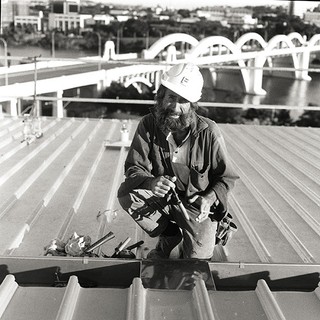
GOMA construction Photograph by Peter Liddy Camera scan of black and white medium format negative / View full image
GOMA HAS BEEN PART OF A HUGE REVOLUTION IN CHILDREN’S ART EDUCATION AND PARTICIPATION — WAS THAT PART OF THE INITIAL BRIEF?
Kerry Clare | Doug Hall AM [former QAG Director], building coordinator William Fleming and architect Michael Barnett [former QAG staff] all contributed to writing an excellent brief. They made it very clear that children are the future appreciation group and to get them to engage was really important.
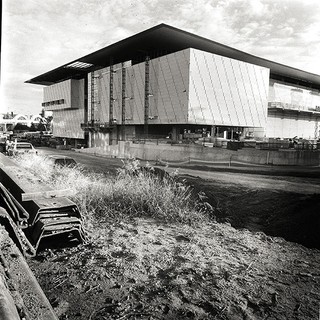
GOMA construction Photograph by Peter Liddy Camera scan of black and white medium format negative / View full image
DO YOU RECALL SOME FAVOURITE ‘ART MOMENTS ’ ?
Kerry Clare | There is an amazing German artist, Katharina Grosse, who was commissioned to respond to a space of her choosing and selected the Long Gallery. She covered the walls and floors with bright colours and shapes using a spray gun. I thought, ‘Wow, she really understands the architecture of this space. She just got it!’ [Katharina Grosse, ‘Picture Park’, 15 Jul 2007 – 28 Oct 2007]

GOMA construction Photograph by Peter Liddy Camera scan of black and white medium format negative / View full image
THE BUILDING IS EASY TO WANDER THROUGH, MAKING IT DEMOCRATIC AND ACCESSIBLE. WOULD YOU SAY THIS IS ASSISTED BY THE CLARITY IN THE PLAN AND YOUR ARRANGEMENT OF THE BUILDING’S AXES?
Kerry Clare | Yes, part of [architect] James Jones’s contribution was to twist it and align with the city grid on the other side of the river and the historic vista up to the windmill [on Wickham Terrace], rather than making it parallel to Grey Street.
Lindsay Clare | That axis has been preserved by the QEII Law Courts, which could have sprawled all over the site. We worked with John Hockings [former Architectus Design Director] on that, to conserve the open space next to the Law Courts and condense the building so that the axis from GOMA to Wickham Terrace was preserved.
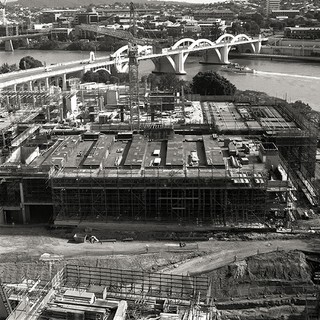
GOMA construction Photograph by Peter Liddy Camera scan of black and white medium format negative / View full image
GOMA IS IMBUED WITH ELEGANCE AND CALM. HOW DID YOU ESTABLISH THIS?
Lindsay Clare | Our general attitude towards buildings is to look for calm. We look for a simplicity that still has a richness, and the ability for the occupants to engage rather than trying to overly-impress or overpower. It also allowed the building to address the outdoor north-east space along the river — that was a key strategic move. In Queensland we understand the north-east corner as the most favourable place to be in summer and winter. The outdoor room on the river is a pleasant gathering space — it’s really just using common sense environmental knowledge and how you make people gather.
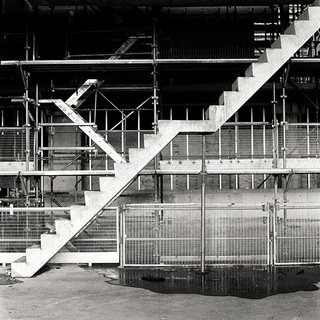
GOMA construction Photograph by Peter Liddy Camera scan of black and white medium format negative / View full image
DO YOU HAVE SOME FAVOURITE GALLERIES ELSEWHERE?
Kerry Clare | After we documented GOMA and it was under construction, we did a tour of galleries around the world. It was the first break we’d had in years! We noticed that when we experienced galleries what we enjoyed most after immersing ourselves in the art inside, was that re-engagement with the context, the town, and with the daylight and surrounds. We recognised that aspect appealed to us subconsciously in a number of galleries.
Lindsay Clare | One we really liked was in Davos in Switzerland, the Kirchner Museum, where you go in then come back out and see the mountains — it connects you to the art and to the place. The materiality of that gallery is exceptional. Gigon/Guyer Architects set up each room around a theme or time period in Kirchner’s life — they are all beautifully choreographed in natural light, timber floors and white walls, and the circulation spaces are in raw concrete, so you feel like you’re in a semiexternal space.
Kerry Clare | We believe our gallery does that too — every time you step out of the space you re-engage with the city, or the river, the trees or the street. A difference is that GOMA has to allow for a huge variety of shows rather than a fixed exhibition like the Kirchner.
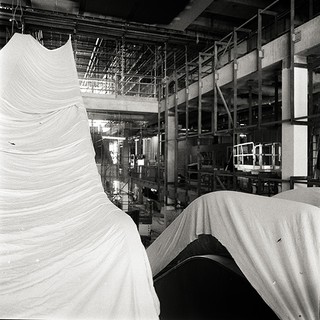
GOMA construction Photograph by Peter Liddy Camera scan of black and white medium format negative / View full image
HOW DOES GOMA’S DESIGN CONTRIBUTE TO A STRONG SENSE OF COMFORT?
Lindsay Clare | It is so important that the edges were sheltered — a big part of the strategy to make people engage with the building, because it provides what you need in the Queensland climate and [allows visitors to] occupy the edges in different ways. GOMA is about connection, connecting people with art, art with the city, the people with the context, and the building to the city. It’s simply about connection.
GOMA. A place where people come together to be inspired and imaginations spark. A place where ideas meet. This summer will be packed with even more excitement as GOMA turns ten. So come along and help us celebrate from 3 December 2016.
In July 2002, Sydney-based company Architectus was commissioned following an Architect Selection Competition to design the Gallery’s second site, the Gallery of Modern Art (GOMA).
On 1 December 2006 GOMA opens. The bold pavilion-style design, expansive galleries and cinémathèque provides a place for people, art and ideas to converge. The building offers an architectural interpretation of what it is to be in a contemporary public space, in a subtropical climate.
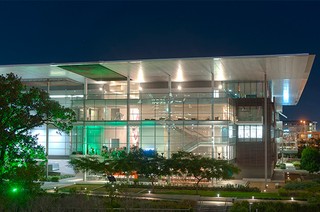
A view of GOMA from the Brisbane River side / Photograph: Mark Sherwood © QAGOMA / View full image

